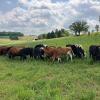Select monthly updates from our team of restoration ecologists, entomologists, plant ecologists, and researchers.
The Xerces Society manages the largest pollinator conservation program in the world. We work with farmers, gardeners, land managers, agency staff, and others to create habitat for bees, butterflies, and beneficial insects—and hundreds of thousands of acres of flower-rich habitat have been planted. We also offer certifications: Bee Better Certification for farmers and food companies who are committed to supporting pollinator conservation in agricultural lands, and Bee City USA and Bee Campus USA certifications for cities and colleges dedicated to making the world safer for pollinators.
With staff based in more than a dozen states, and offering a diverse array of expertise, it can be challenging to summarize the impactful work being done by our team of restoration ecologists, entomologists, plant ecologists, and researchers. Therefore, we have compiled select pollinator conservation program updates into monthly digests. August’s featured staff members conducted a successful pollinator habitat workshop in Nebraska, and have been busy building beetle banks at a variety of locations in Iowa.
Nebraska Pollinator Habitat Workshop Provides Opportunity to Learn from Each Other's Experiences
RaeAnn Powers, Farm Bill Pollinator Conservation Planner, Nebraska
The hot Nebraska sun didn’t stop us from gathering in July at Ponca State Park in northeast Nebraska, when Nebraska Game and Parks Commission, the Xerces Society, and other partners hosted a pollinator habitat establishment and management workshop. Approximately 90 conservation professionals gathered to learn from each other’s experiences with establishing and maintaining pollinator habitat. Although most attendees were from within the state, a few South Dakotans and Iowans traveled to join us. The park where we hosted the event is located along the Missouri River bluffs with dense woodlands, prairie ridge tops, and wet meadow river floodplains—a great place to discuss all types of habitat!
We spent the morning learning about Nebraska’s unique pollinators, general pollinator habitat needs, and pollinator identification. Presentations from land managers and conservationists highlighted challenges in establishing pollinator habitat and how methods have changed through time—from monoculture sunflower plantings for pollinators in the 1980s to the diverse wildflower and native grass plantings we encourage today. Before breaking for lunch, our expert presenters led a panel discussion fielding questions on a variety of topics, from combating invasive Canada thistle (Cirsium arvense) to creating roadside habitat for butterflies.
In the afternoon, we headed out to explore sites restored to wildlife habitat near the park. We toured a previously cropped site where native grasses and wildflowers were thriving, but the trees planted to create a savanna community had failed because of extensive browsing from deer. Site managers led us through the site and described its history and management while pointing out plant and pollinator species. The blooms we observed included milkweeds, sunflowers, and tick clovers. After this sweltering field session, we were not only inspired and excited for future projects, but also grateful to head towards air conditioning!

Supporting Natural Pest Control by Building Beetle Banks
Sarah Foltz Jordan, Senior Pollinator Conservation Specialist & Habitat Restoration Specialist, Great Lakes Region
Much of my habitat work this summer has focused on "beetle banks"—long, linear strips of native plants integrated into crop fields to provide shelter for predatory ground beetles and other insects. These creatures, in turn, help to support natural pest control and pollination on farms. Historically more common in Great Britain, this practice has been gaining momentum in the United States’ upper Midwest region.
We are currently installing beetle banks on five Iowa farms, ranging from a 68-acre organic vegetable community-supported agriculture (CSA) farm in central Iowa, to a 300-acre organic grain farm in the northwest corner of the state. Beetle banks are especially well-suited for organic farms, since these cropping systems are often highly reliant on beneficial insects for pest control, yet also utilize regular cultivation for weed control. Beetle banks offer ground-dwelling insects a refuge from soil disturbance, and help promote movement of pollinators and predators into crop fields where their pollination and pest control services are most needed.
Beetle banks are typically composed of native bunch grasses, with a smaller wildflower component. For our Iowa farms, we are doing comparisons of habitat establishment starting from seeds versus plugs (small plants), and also experimenting with a variety of organic weed control methods prior to getting the native vegetation established. Organic methods that we are using on these farms include: buckwheat smother cropping (growing a dense crop of buckwheat to smother out existing vegetation), and stale seed bedding (using irrigation and tarps to encourage the germination and subsequent death of weed seeds).
Funded by the Iowa Natural Resource Conservation Service (NRCS) Conservation Innovation Grant (CIG), these habitat projects will serve as demonstration sites for other farmers to learn more about the process of installing habitat, and the value of that habitat to both wildlife and farm production. We are offering field days in partnership with the Practical Farmers of Iowa at several farms, including a recent event at the Mugge Farm, and an upcoming event at Scattergood Farm near Iowa City on September 17. Researchers at Luther College are involved in monitoring the projects for ground beetle abundance both within the beetle banks, and in adjacent crop fields.

Additional Resources
Learn more about the Xerces Society’s Pollinator Conservation Program




